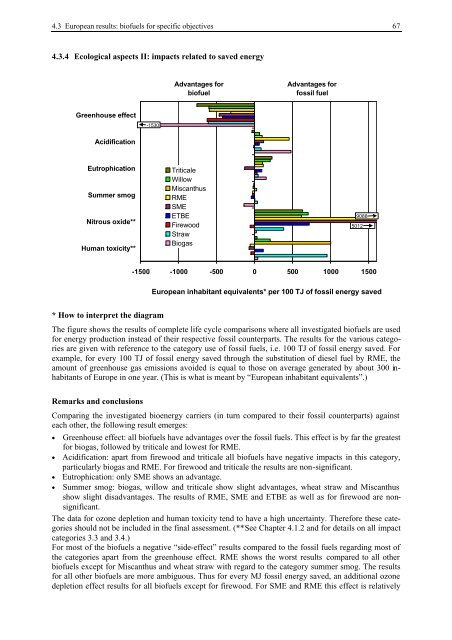BIOENERGY FOR EUROPE: WHICH ONES FIT BEST?
BIOENERGY FOR EUROPE: WHICH ONES FIT BEST?
BIOENERGY FOR EUROPE: WHICH ONES FIT BEST?
Create successful ePaper yourself
Turn your PDF publications into a flip-book with our unique Google optimized e-Paper software.
4.3 European results: biofuels for specific objectives 67<br />
4.3.4 Ecological aspects II: impacts related to saved energy<br />
Greenhouse effect<br />
Acidification<br />
Eutrophication<br />
Summer smog<br />
Nitrous oxide**<br />
Human toxicity**<br />
-1530<br />
* How to interpret the diagram<br />
Advantages for<br />
biofuel<br />
Triticale<br />
Willow<br />
Miscanthus<br />
RME<br />
SME<br />
ETBE<br />
Firewood<br />
Straw<br />
Biogas<br />
Advantages for<br />
fossil fuel<br />
-1500 -1000 -500 0 500 1000 1500<br />
European inhabitant equivalents* per 100 TJ of fossil energy saved<br />
The figure shows the results of complete life cycle comparisons where all investigated biofuels are used<br />
for energy production instead of their respective fossil counterparts. The results for the various categories<br />
are given with reference to the category use of fossil fuels, i.e. 100 TJ of fossil energy saved. For<br />
example, for every 100 TJ of fossil energy saved through the substitution of diesel fuel by RME, the<br />
amount of greenhouse gas emissions avoided is equal to those on average generated by about 300 inhabitants<br />
of Europe in one year. (This is what is meant by “European inhabitant equivalents”.)<br />
Remarks and conclusions<br />
Comparing the investigated bioenergy carriers (in turn compared to their fossil counterparts) against<br />
each other, the following result emerges:<br />
• Greenhouse effect: all biofuels have advantages over the fossil fuels. This effect is by far the greatest<br />
for biogas, followed by triticale and lowest for RME.<br />
• Acidification: apart from firewood and triticale all biofuels have negative impacts in this category,<br />
particularly biogas and RME. For firewood and triticale the results are non-significant.<br />
• Eutrophication: only SME shows an advantage.<br />
• Summer smog: biogas, willow and triticale show slight advantages, wheat straw and Miscanthus<br />
show slight disadvantages. The results of RME, SME and ETBE as well as for firewood are nonsignificant.<br />
The data for ozone depletion and human toxicity tend to have a high uncertainty. Therefore these categories<br />
should not be included in the final assessment. (**See Chapter 4.1.2 and for details on all impact<br />
categories 3.3 and 3.4.)<br />
For most of the biofuels a negative “side-effect” results compared to the fossil fuels regarding most of<br />
the categories apart from the greenhouse effect. RME shows the worst results compared to all other<br />
biofuels except for Miscanthus and wheat straw with regard to the category summer smog. The results<br />
for all other biofuels are more ambiguous. Thus for every MJ fossil energy saved, an additional ozone<br />
depletion effect results for all biofuels except for firewood. For SME and RME this effect is relatively<br />
9088<br />
5012

















